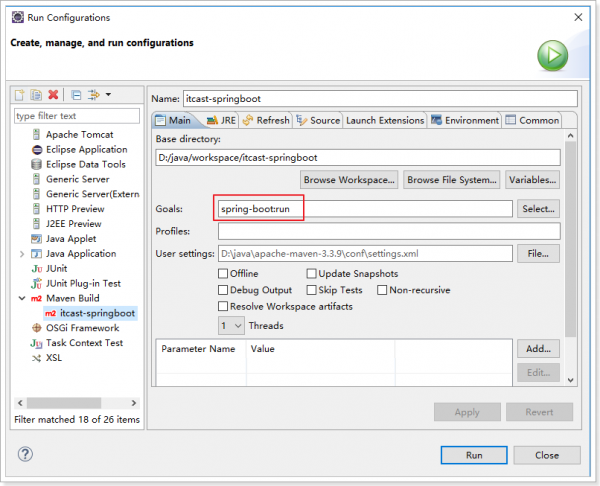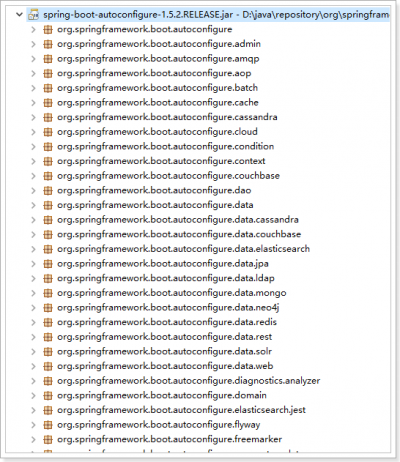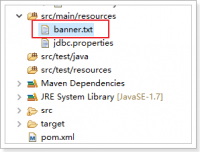“SpringBoot:快速入门”的版本间差异
(→快速入门) |
|||
| 第335行: | 第335行: | ||
== SpringBoot核心 == | == SpringBoot核心 == | ||
=== 入口类和@SpringBootApplication === | |||
Spring Boot的项目一般都会有“xxxApplication”的入口类,类中有main方法,这是一个标准的Java应用程序的入口方法。<br/> | |||
<syntaxhighlight lang="java"> | |||
@Controller | |||
@SpringBootApplication(exclude = { RedisAutoConfiguration.class }) | |||
@Configuration | |||
public class HelloApplication { | |||
public static void main(String[] args) { | |||
SpringApplication.run(HelloApplication.class, args); | |||
} | |||
} | |||
</syntaxhighlight> | |||
其中:“'''@SpringBootApplication'''”:是Spring Boot的核心注解,它其实是一个组合注解: | |||
<syntaxhighlight lang="java"> | |||
@Target(ElementType.TYPE) | |||
@Retention(RetentionPolicy.RUNTIME) | |||
@Documented | |||
@Inherited | |||
@SpringBootConfiguration | |||
@EnableAutoConfiguration | |||
@ComponentScan(excludeFilters = { | |||
@Filter(type = FilterType.CUSTOM, classes = TypeExcludeFilter.class), | |||
@Filter(type = FilterType.CUSTOM, classes = AutoConfigurationExcludeFilter.class) }) | |||
public @interface SpringBootApplication { | |||
</syntaxhighlight> | |||
# “'''@SpringBootConfiguration'''”:Spring Boot项目的'''配置'''注解(组合注解): | |||
#: <syntaxhighlight lang="java"> | |||
@Target({ElementType.TYPE}) | |||
@Retention(RetentionPolicy.RUNTIME) | |||
@Documented | |||
@Configuration | |||
public @interface SpringBootConfiguration { | |||
} | |||
</syntaxhighlight> | |||
#* 在Spring Boot中推荐使用“@SpringBootConfiguration”替代“@Configuration”; | |||
# “'''@EnableAutoConfiguration'''”:'''启用自动配置''',该注解会使Spring Boot根据项目中依赖的jar包自动配置项目的配置项: | |||
# “'''@ComponentScan'''”:默认扫描“@SpringBootApplication”所在类的同级目录,以及它的子目录; | |||
=== 关闭自动配置 === | |||
启用自动配置时,Spring Boot会根据项目中的jar包依赖,自动做出配置;而Spring Boot支持的自动配置如下(非常多): | |||
:[[File:SpringBoot启动应用:自动配置.png|400px]] | |||
如果不需要Spring Boot自动配置,想关闭某一项的自动配置(以Redis为例): | |||
<syntaxhighlight lang="java"> | |||
@Controller | |||
@SpringBootApplication(exclude = { RedisAutoConfiguration.class }) | |||
@Configuration | |||
public class HelloApplication { | |||
</syntaxhighlight> | |||
=== 自定义Banner === | |||
启动Spring Boot项目后会看到默认的Banner: | |||
:[[File:SpringBoot启动应用:Banner.png|600px]] | |||
* 关闭Banner: | |||
*: <syntaxhighlight lang="java"> | |||
public static void main(String[] args) { | |||
// SpringApplication.run(HelloApplication.class, args); | |||
SpringApplication application = new SpringApplication(HelloApplication.class); | |||
application.setBannerMode(Mode.OFF); | |||
application.run(args); | |||
} | |||
</syntaxhighlight> | |||
* 自定义Banner: | |||
*# 在[http://patorjk.com/software/taag/#p=display&h=3&v=3&f=4Max&t=itcast%20Spring%20Boot 工具站点]中生成Banner,并保存为“banner.txt”; | |||
*# 将banner.txt拷贝到项目的resources目录; | |||
*#: [[File:SpringBoot启动应用:Banner自定义.png|200px]] | |||
=== 全局配置文件 === | |||
Spring Boot项目使用一个全局的配置文件“application.properties”(或“application.yml”),在“resources”目录下(或:类路径下的“/config”下)。<br/> | |||
可以进行项目全局配置,如: | |||
: <syntaxhighlight lang="properties"> | |||
server.port=8088 | |||
server.servlet-path=/ | |||
spring.resources.static-locations=classpath:/public/ | |||
logging.level.org.springframework=DEBUG | |||
</syntaxhighlight> | |||
* 更多配置:'''[[SpringBoot全局配置]]''' | |||
=== Starter pom === | |||
Starter POMs是可以包含到应用中的一个方便的“依赖关系描述符集合”。 | |||
* 可以通过starters获取所有Spring及相关技术的一站式服务,而不需要翻阅示例代码,拷贝粘贴大量的依赖描述符; | |||
* 所有的starters遵循一个相似的命名模式:“'''spring-boot-starter-*'''”; | |||
例如:在 SpringBoot 项目中集成 Redis,那么我只需要加入“spring-data-redis-starter”的依赖: | |||
<syntaxhighlight lang="xml"> | |||
<dependency> | |||
<groupId>org.springframework.boot</groupId> | |||
<artifactId>spring-boot-starter-data-redis</artifactId> | |||
</dependency> | |||
</syntaxhighlight> | |||
而不需考虑与其他内容的依赖、版本等; | |||
官方支持的 starter pom:(2.3.5.RELEASE) | |||
{| class="wikitable" | |||
! 名称 !! 描述 | |||
|- | |||
! colspan="2"| application starters | |||
|- | |||
| spring-boot-starter || Core starter, including auto-configuration support, logging and YAML | |||
|- | |||
| spring-boot-starter-activemq || Starter for JMS messaging using Apache ActiveMQ | |||
|- | |||
| spring-boot-starter-amqp || Starter for using Spring AMQP and Rabbit MQ | |||
|- | |||
| spring-boot-starter-aop || Starter for aspect-oriented programming with Spring AOP and AspectJ | |||
|- | |||
| spring-boot-starter-artemis || Starter for JMS messaging using Apache Artemis | |||
|- | |||
| spring-boot-starter-batch || Starter for using Spring Batch | |||
|- | |||
| spring-boot-starter-cache || Starter for using Spring Framework’s caching support | |||
|- | |||
| spring-boot-starter-data-cassandra || Starter for using Cassandra distributed database and Spring Data Cassandra | |||
|- | |||
| spring-boot-starter-data-cassandra-reactive || Starter for using Cassandra distributed database and Spring Data Cassandra Reactive | |||
|- | |||
| spring-boot-starter-data-couchbase || Starter for using Couchbase document-oriented database and Spring Data Couchbase | |||
|- | |||
| spring-boot-starter-data-couchbase-reactive || Starter for using Couchbase document-oriented database and Spring Data Couchbase Reactive | |||
|- | |||
| spring-boot-starter-data-elasticsearch || Starter for using Elasticsearch search and analytics engine and Spring Data Elasticsearch | |||
|- | |||
| spring-boot-starter-data-jdbc || Starter for using Spring Data JDBC | |||
|- | |||
| spring-boot-starter-data-jpa || Starter for using Spring Data JPA with Hibernate | |||
|- | |||
| spring-boot-starter-data-ldap || Starter for using Spring Data LDAP | |||
|- | |||
| spring-boot-starter-data-mongodb || Starter for using MongoDB document-oriented database and Spring Data MongoDB | |||
|- | |||
| spring-boot-starter-data-mongodb-reactive || Starter for using MongoDB document-oriented database and Spring Data MongoDB Reactive | |||
|- | |||
| spring-boot-starter-data-neo4j || Starter for using Neo4j graph database and Spring Data Neo4j | |||
|- | |||
| spring-boot-starter-data-r2dbc || Starter for using Spring Data R2DBC | |||
|- | |||
| spring-boot-starter-data-redis || Starter for using Redis key-value data store with Spring Data Redis and the Lettuce client | |||
|- | |||
| spring-boot-starter-data-redis-reactive || Starter for using Redis key-value data store with Spring Data Redis reactive and the Lettuce client | |||
|- | |||
| spring-boot-starter-data-rest || Starter for exposing Spring Data repositories over REST using Spring Data REST | |||
|- | |||
| spring-boot-starter-data-solr || Starter for using the Apache Solr search platform with Spring Data Solr | |||
|- | |||
| spring-boot-starter-freemarker || Starter for building MVC web applications using FreeMarker views | |||
|- | |||
| spring-boot-starter-groovy-templates || Starter for building MVC web applications using Groovy Templates views | |||
|- | |||
| spring-boot-starter-hateoas || Starter for building hypermedia-based RESTful web application with Spring MVC and Spring HATEOAS | |||
|- | |||
| spring-boot-starter-integration || Starter for using Spring Integration | |||
|- | |||
| spring-boot-starter-jdbc || Starter for using JDBC with the HikariCP connection pool | |||
|- | |||
| spring-boot-starter-jersey || Starter for building RESTful web applications using JAX-RS and Jersey. An alternative to spring-boot-starter-web | |||
|- | |||
| spring-boot-starter-jooq || Starter for using jOOQ to access SQL databases. An alternative to spring-boot-starter-data-jpa or spring-boot-starter-jdbc | |||
|- | |||
| spring-boot-starter-json || Starter for reading and writing json | |||
|- | |||
| spring-boot-starter-jta-atomikos || Starter for JTA transactions using Atomikos | |||
|- | |||
| spring-boot-starter-jta-bitronix || Starter for JTA transactions using Bitronix. Deprecated since 2.3.0 | |||
|- | |||
| spring-boot-starter-mail || Starter for using Java Mail and Spring Framework’s email sending support | |||
|- | |||
| spring-boot-starter-mustache || Starter for building web applications using Mustache views | |||
|- | |||
| spring-boot-starter-oauth2-client || Starter for using Spring Security’s OAuth2/OpenID Connect client features | |||
|- | |||
| spring-boot-starter-oauth2-resource-server || Starter for using Spring Security’s OAuth2 resource server features | |||
|- | |||
| spring-boot-starter-quartz || Starter for using the Quartz scheduler | |||
|- | |||
| spring-boot-starter-rsocket || Starter for building RSocket clients and servers | |||
|- | |||
| spring-boot-starter-security || Starter for using Spring Security | |||
|- | |||
| spring-boot-starter-test || Starter for testing Spring Boot applications with libraries including JUnit, Hamcrest and Mockito | |||
|- | |||
| spring-boot-starter-thymeleaf || Starter for building MVC web applications using Thymeleaf views | |||
|- | |||
| spring-boot-starter-validation || Starter for using Java Bean Validation with Hibernate Validator | |||
|- | |||
| spring-boot-starter-web || Starter for building web, including RESTful, applications using Spring MVC. Uses Tomcat as the default embedded container | |||
|- | |||
| spring-boot-starter-web-services || Starter for using Spring Web Services | |||
|- | |||
| spring-boot-starter-webflux || Starter for building WebFlux applications using Spring Framework’s Reactive Web support | |||
|- | |||
| spring-boot-starter-websocket || Starter for building WebSocket applications using Spring Framework’s WebSocket support | |||
|- | |||
! colspan="2"| production starters | |||
|- | |||
| spring-boot-starter-actuator || Starter for using Spring Boot’s Actuator which provides production ready features to help you monitor and manage your application | |||
|- | |||
! colspan="2"| technical starters | |||
|- | |||
| spring-boot-starter-jetty || Starter for using Jetty as the embedded servlet container. An alternative to spring-boot-starter-tomcat | |||
|- | |||
| spring-boot-starter-log4j2 || Starter for using Log4j2 for logging. An alternative to spring-boot-starter-logging | |||
|- | |||
| spring-boot-starter-logging || Starter for logging using Logback. Default logging starter | |||
|- | |||
| spring-boot-starter-reactor-netty || Starter for using Reactor Netty as the embedded reactive HTTP server. | |||
|- | |||
| spring-boot-starter-tomcat || Starter for using Tomcat as the embedded servlet container. Default servlet container starter used by spring-boot-starter-web | |||
|- | |||
| spring-boot-starter-undertow || Starter for using Undertow as the embedded servlet container. An alternative to spring-boot-starter-tomcat | |||
|} | |||
=== Xml 配置文件 === | |||
# “'''@PropertySource'''”:加载指定的配置文件; | |||
#* 只能加载“*.properties”文件,不能加载“.yaml”文件; | |||
#: <syntaxhighlight lang="java"> | |||
@PropertySource(value = { "classpath:jdbc.properties" }, ignoreResourceNotFound = true) | |||
</syntaxhighlight> | |||
# “'''@Import'''”: | |||
#* 4.2之前,只支持导入配置类;(相当于“<import resource=""/>”标签) | |||
#* 4.2之后,支持导入普通的java类,并将其声明成一个bean; | |||
#: <syntaxhighlight lang="java"> | |||
@Import({ CustomerConfig.class, SchedulerConfig.class }) | |||
</syntaxhighlight> | |||
# “'''@ImportResource'''”:导入Spring的配置文件,让配置文件里面的内容生效; | |||
#* SpringBoot中编写的Spring配置文件是不能自动识别的;【???】 | |||
#: <syntaxhighlight lang="java"> | |||
@ImportResource(locations = {"classpath:applicationContext.xml"}) | |||
</syntaxhighlight> | |||
=== 日志 === | |||
Spring Boot对各种日志框架都做了支持,可以通过全局配置来修改默认的日志的配置: | |||
<syntaxhighlight lang="properties"> | |||
#设置日志级别 | |||
logging.level.*= # Log levels severity mapping. For instance `logging.level.org.springframework=DEBUG` | |||
</syntaxhighlight> | |||
== 自动配置的原理 == | == 自动配置的原理 == | ||
2020年11月3日 (二) 01:57的版本
Spring的发展
- Spring1.x:
- 通过xml文件配置bean:随着项目的不断扩大,需要将xml配置分放到不同的配置文件中,需要频繁的在java类和xml配置文件中切换。
- Spring2.x:
- (JDK 1.5 注解支持)使用注解对Bean进行申明和注入:大大的减少了xml配置文件,同时也大大简化了项目的开发。
- 应用的基本配置用xml(如:数据源、资源文件等);
- 业务开发用注解(如:Service中注入bean等);
- Spring3.x(Spring4.x):
- 推荐使用Java配置方式:可以完全替代xml配置。
Spring的Java配置方式
(Java配置是Spring4.x推荐的配置方式)
Spring的Java配置方式是通过 @Configuration 和 @Bean 这两个注解实现的:
- @Configuration:标记类,相当于一个xml配置文件;
- @Bean:标记方法,相当于xml配置中的“<bean>”;
其他配置类注解:
- 读取外部的资源配置文件:
- @PropertySource:指定读取的配置文件;
- @Value:获取配置文件的配置项;
示例:配置数据库连接池:
// 通过该注解来表明该类是一个Spring的配置,相当于一个xml文件 @Configuration // 配置扫描包,相当于xml中的"<context:component-scan ...>" @ComponentScan(basePackages = "cn.itcast.springboot.javaconfig") //加载配置文件 @PropertySource(value = { "classpath:jdbc.properties", "xxx.properties" }, ignoreResourceNotFound = true) public class SpringConfig { @Bean // 通过该注解来表明是一个Bean对象,相当于xml中的<bean> //1、相当于xml中的<bean>标签 //2、相当于类中的@Service类的注解 //所以"UserDAO"可以用于"UserService"属性注入 public UserDAO getUserDAO() { return new UserDAO(); // 直接new对象做演示 } //返回值,相当于<bean>中的"class"属性 //方法名称,相当于<bean>中的"id"属性? // 获取配置文件的配置项 @Value("${jdbc.url}") private String jdbcUrl; @Value("${jdbc.driverClassName}") private String jdbcDriverClassName; @Value("${jdbc.username}") private String jdbcUsername; @Value("${jdbc.password}") private String jdbcPassword; @Bean(destroyMethod = "close") public DataSource dataSource() { BoneCPDataSource boneCPDataSource = new BoneCPDataSource(); // 数据库驱动 boneCPDataSource.setDriverClass(jdbcDriverClassName); // 相应驱动的jdbcUrl boneCPDataSource.setJdbcUrl(jdbcUrl); // 数据库的用户名 boneCPDataSource.setUsername(jdbcUsername); // 数据库的密码 boneCPDataSource.setPassword(jdbcUsername); // 检查数据库连接池中空闲连接的间隔时间,单位是分,默认值:240,如果要取消则设置为0 boneCPDataSource.setIdleConnectionTestPeriodInMinutes(60); // 连接池中未使用的链接最大存活时间,单位是分,默认值:60,如果要永远存活设置为0 boneCPDataSource.setIdleMaxAgeInMinutes(30); // 每个分区最大的连接数 boneCPDataSource.setMaxConnectionsPerPartition(100); // 每个分区最小的连接数 boneCPDataSource.setMinConnectionsPerPartition(5); return boneCPDataSource; } }
实例
- 创建工程以及导入依赖:
<project xmlns="http://maven.apache.org/POM/4.0.0" xmlns:xsi="http://www.w3.org/2001/XMLSchema-instance" xsi:schemaLocation="http://maven.apache.org/POM/4.0.0 http://maven.apache.org/xsd/maven-4.0.0.xsd"> <modelVersion>4.0.0</modelVersion> <groupId>cn.itcast.springboot</groupId> <artifactId>itcast-springboot</artifactId> <version>1.0.0-SNAPSHOT</version> <packaging>war</packaging> <dependencies> <dependency> <groupId>org.springframework</groupId> <artifactId>spring-webmvc</artifactId> <version>4.3.7.RELEASE</version> </dependency> <!-- 连接池 --> <dependency> <groupId>com.jolbox</groupId> <artifactId>bonecp-spring</artifactId> <version>0.8.0.RELEASE</version> </dependency> </dependencies> <build> <finalName>${project.artifactId}</finalName> <plugins> <!-- 资源文件拷贝插件 --> <plugin> <groupId>org.apache.maven.plugins</groupId> <artifactId>maven-resources-plugin</artifactId> <configuration> <encoding>UTF-8</encoding> </configuration> </plugin> <!-- java编译插件 --> <plugin> <groupId>org.apache.maven.plugins</groupId> <artifactId>maven-compiler-plugin</artifactId> <configuration> <source>1.7</source> <target>1.7</target> <encoding>UTF-8</encoding> </configuration> </plugin> </plugins> <pluginManagement> <plugins> <!-- 配置Tomcat插件 --> <plugin> <groupId>org.apache.tomcat.maven</groupId> <artifactId>tomcat7-maven-plugin</artifactId> <version>2.2</version> </plugin> </plugins> </pluginManagement> </build> </project>
- 编写User对象:
public class User { private String username; private String password; private Integer age; // getter & setter & toString }
- 编写UserDao接口:
public interface UserDaoUserDao { //根据id查询用户信息 public User findUserById(int id) throws Exception; }
- 编写UserDaoImpl接口:(mybatis)
public class UserDaoImpl implements UserDao { // 需要向dao实现类中注入SqlSessionFactory // 这里通过构造方法注入 private SqlSessionFactory sqlSessionFactory; public UserDaoImpl(SqlSessionFactory sqlSessionFactory) { this.sqlSessionFactory = sqlSessionFactory; } @Override public User findUserById(int id) throws Exception { SqlSession sqlSession = sqlSessionFactory.openSession(); User user = sqlSession.selectOne("test.findUserById", id); // 释放资源 sqlSession.close(); return user; } }
- 编写UserService实现User数据操作业务逻辑:
@Service public class UserService { @Autowired // 注入Spring容器中的bean对象 private UserDaoImpl UserDaoImpl; public User findUserById(int id) throws Exception { // 调用userDAO中的方法进行查询 return this.UserDaoImpl.findUserById(id); } }
- 编写SpringConfig用于实例化Spring容器:
@Configuration //通过该注解来表明该类是一个Spring的配置,相当于一个xml文件 @ComponentScan(basePackages = "cn.itcast.springboot.javaconfig") //配置扫描包 public class SpringConfig { @Bean // 通过该注解来表明是一个Bean对象,相当于xml中的<bean> public UserDao getUserDao(){ return new UserDao(); // 直接new对象做演示 } }
- 编写测试方法,启动Spring容器:
public class Main { public static void main(String[] args) { // 通过Java配置来实例化Spring容器 AnnotationConfigApplicationContext context = new AnnotationConfigApplicationContext(SpringConfig.class); // 对比使用:使用xml方式的“加载spring配置文件” ApplicationContext context = new ClassPathXmlApplicationContext("bean1.xml"); // 对比使用:使用xml方式的“根据配置创建对象” UserService userService = (UserService) context.getBean("userService"); // 在Spring容器中获取Bean对象 UserService userService = context.getBean(UserService.class); // 调用对象中的方法 List<User> list = userService.queryUserList(); for (User user : list) { System.out.println(user.getUsername() + ", " + user.getPassword() + ", " + user.getPassword()); } // 销毁该容器 context.destroy(); } }
实例化Spring容器:xml与Java配置
对比,“xml、注解”于“Java配置类”的实例化Spring容器:
// 通过Java配置来实例化Spring容器
// 1、Java配置类
AnnotationConfigApplicationContext context = new AnnotationConfigApplicationContext(SpringConfig.class);
// 2、xml、注解
ApplicationContext context = new ClassPathXmlApplicationContext("applicationContext.xml");
// 在Spring容器中“获取Bean对象”
// 1、Java配置类
UserService userService = context.getBean(UserService.class);
// 2、xml、注解
UserService userService = (UserService) context.getBean("userService");
Spring Boot
“习惯优于配置”:
SpringBoot是一种全新的框架,目的是为了简化Spring应用的初始搭建以及开发过程。该框架使用特定的方式(集成starter,约定优于配置)来进行配置,从而使开发人员不需要再定义样板化的配置。
- SpringBoot基于Sring4进行设计,继承了原有Spring框架的优秀基因。
- SpringBoot并不是一个框架,而是一些类库的集合。
- maven或者gradle项目导入相应依赖即可使用SpringBoot,而无需自行管理这些类库的版本。
优点:
- 快速创建基于Spring的应用程序。
- 无需手动管理依赖包的版本。
- 自动配置,无需XML。
- 嵌入式的Tomcat,无需部署war文件。
快速入门
设置spring boot的parent
<parent>
<groupId>org.springframework.boot</groupId>
<artifactId>spring-boot-starter-parent</artifactId>
<version>1.5.2.RELEASE</version>
</parent>
Spring boot的项目必须要将parent设置为spring boot的parent,该parent包含了大量默认的配置,大大简化了我们的开发。
导入spring boot的web支持
<dependencies>
<dependency>
<groupId>org.springframework.boot</groupId>
<artifactId>spring-boot-starter-web</artifactId>
</dependency>
</dependencies>
添加Spring boot的插件
<build>
<finalName>${project.artifactId}</finalName>
<plugins>
<plugin>
<groupId>org.springframework.boot</groupId>
<artifactId>spring-boot-maven-plugin</artifactId>
</plugin>
</plugins>
<pluginManagement>
...
</pluginManagement>
</build>
编写第一个Spring Boot的应用
@Controller
@SpringBootApplication
@Configuration
public class HelloApplication {
@RequestMapping("hello")
@ResponseBody
public String hello(){
return "hello world!";
}
public static void main(String[] args) {
SpringApplication.run(HelloApplication.class, args);
}
}
- @SpringBootApplication:Spring Boot项目的核心注解,主要目的是开启自动配置;
- @Configuration:这是一个配置Spring的配置类;
- @Controller:标明这是一个SpringMVC的Controller控制器;
- main方法:在main方法中启动一个应用,即:这个应用的入口;
启动应用
在Spring Boot项目中,启动的方式有两种,一种是另外一种是。
SpringBoot核心
入口类和@SpringBootApplication
Spring Boot的项目一般都会有“xxxApplication”的入口类,类中有main方法,这是一个标准的Java应用程序的入口方法。
@Controller
@SpringBootApplication(exclude = { RedisAutoConfiguration.class })
@Configuration
public class HelloApplication {
public static void main(String[] args) {
SpringApplication.run(HelloApplication.class, args);
}
}
其中:“@SpringBootApplication”:是Spring Boot的核心注解,它其实是一个组合注解:
@Target(ElementType.TYPE)
@Retention(RetentionPolicy.RUNTIME)
@Documented
@Inherited
@SpringBootConfiguration
@EnableAutoConfiguration
@ComponentScan(excludeFilters = {
@Filter(type = FilterType.CUSTOM, classes = TypeExcludeFilter.class),
@Filter(type = FilterType.CUSTOM, classes = AutoConfigurationExcludeFilter.class) })
public @interface SpringBootApplication {
- “@SpringBootConfiguration”:Spring Boot项目的配置注解(组合注解):
@Target({ElementType.TYPE}) @Retention(RetentionPolicy.RUNTIME) @Documented @Configuration public @interface SpringBootConfiguration { }
- 在Spring Boot中推荐使用“@SpringBootConfiguration”替代“@Configuration”;
- “@EnableAutoConfiguration”:启用自动配置,该注解会使Spring Boot根据项目中依赖的jar包自动配置项目的配置项:
- “@ComponentScan”:默认扫描“@SpringBootApplication”所在类的同级目录,以及它的子目录;
关闭自动配置
启用自动配置时,Spring Boot会根据项目中的jar包依赖,自动做出配置;而Spring Boot支持的自动配置如下(非常多):
如果不需要Spring Boot自动配置,想关闭某一项的自动配置(以Redis为例):
@Controller
@SpringBootApplication(exclude = { RedisAutoConfiguration.class })
@Configuration
public class HelloApplication {
自定义Banner
启动Spring Boot项目后会看到默认的Banner:
- 关闭Banner:
public static void main(String[] args) { // SpringApplication.run(HelloApplication.class, args); SpringApplication application = new SpringApplication(HelloApplication.class); application.setBannerMode(Mode.OFF); application.run(args); }
- 自定义Banner:
- 在工具站点中生成Banner,并保存为“banner.txt”;
- 将banner.txt拷贝到项目的resources目录;
全局配置文件
Spring Boot项目使用一个全局的配置文件“application.properties”(或“application.yml”),在“resources”目录下(或:类路径下的“/config”下)。
可以进行项目全局配置,如:
server.port=8088 server.servlet-path=/ spring.resources.static-locations=classpath:/public/ logging.level.org.springframework=DEBUG
- 更多配置:SpringBoot全局配置
Starter pom
Starter POMs是可以包含到应用中的一个方便的“依赖关系描述符集合”。
- 可以通过starters获取所有Spring及相关技术的一站式服务,而不需要翻阅示例代码,拷贝粘贴大量的依赖描述符;
- 所有的starters遵循一个相似的命名模式:“spring-boot-starter-*”;
例如:在 SpringBoot 项目中集成 Redis,那么我只需要加入“spring-data-redis-starter”的依赖:
<dependency>
<groupId>org.springframework.boot</groupId>
<artifactId>spring-boot-starter-data-redis</artifactId>
</dependency>
而不需考虑与其他内容的依赖、版本等;
官方支持的 starter pom:(2.3.5.RELEASE)
| 名称 | 描述 |
|---|---|
| application starters | |
| spring-boot-starter | Core starter, including auto-configuration support, logging and YAML |
| spring-boot-starter-activemq | Starter for JMS messaging using Apache ActiveMQ |
| spring-boot-starter-amqp | Starter for using Spring AMQP and Rabbit MQ |
| spring-boot-starter-aop | Starter for aspect-oriented programming with Spring AOP and AspectJ |
| spring-boot-starter-artemis | Starter for JMS messaging using Apache Artemis |
| spring-boot-starter-batch | Starter for using Spring Batch |
| spring-boot-starter-cache | Starter for using Spring Framework’s caching support |
| spring-boot-starter-data-cassandra | Starter for using Cassandra distributed database and Spring Data Cassandra |
| spring-boot-starter-data-cassandra-reactive | Starter for using Cassandra distributed database and Spring Data Cassandra Reactive |
| spring-boot-starter-data-couchbase | Starter for using Couchbase document-oriented database and Spring Data Couchbase |
| spring-boot-starter-data-couchbase-reactive | Starter for using Couchbase document-oriented database and Spring Data Couchbase Reactive |
| spring-boot-starter-data-elasticsearch | Starter for using Elasticsearch search and analytics engine and Spring Data Elasticsearch |
| spring-boot-starter-data-jdbc | Starter for using Spring Data JDBC |
| spring-boot-starter-data-jpa | Starter for using Spring Data JPA with Hibernate |
| spring-boot-starter-data-ldap | Starter for using Spring Data LDAP |
| spring-boot-starter-data-mongodb | Starter for using MongoDB document-oriented database and Spring Data MongoDB |
| spring-boot-starter-data-mongodb-reactive | Starter for using MongoDB document-oriented database and Spring Data MongoDB Reactive |
| spring-boot-starter-data-neo4j | Starter for using Neo4j graph database and Spring Data Neo4j |
| spring-boot-starter-data-r2dbc | Starter for using Spring Data R2DBC |
| spring-boot-starter-data-redis | Starter for using Redis key-value data store with Spring Data Redis and the Lettuce client |
| spring-boot-starter-data-redis-reactive | Starter for using Redis key-value data store with Spring Data Redis reactive and the Lettuce client |
| spring-boot-starter-data-rest | Starter for exposing Spring Data repositories over REST using Spring Data REST |
| spring-boot-starter-data-solr | Starter for using the Apache Solr search platform with Spring Data Solr |
| spring-boot-starter-freemarker | Starter for building MVC web applications using FreeMarker views |
| spring-boot-starter-groovy-templates | Starter for building MVC web applications using Groovy Templates views |
| spring-boot-starter-hateoas | Starter for building hypermedia-based RESTful web application with Spring MVC and Spring HATEOAS |
| spring-boot-starter-integration | Starter for using Spring Integration |
| spring-boot-starter-jdbc | Starter for using JDBC with the HikariCP connection pool |
| spring-boot-starter-jersey | Starter for building RESTful web applications using JAX-RS and Jersey. An alternative to spring-boot-starter-web |
| spring-boot-starter-jooq | Starter for using jOOQ to access SQL databases. An alternative to spring-boot-starter-data-jpa or spring-boot-starter-jdbc |
| spring-boot-starter-json | Starter for reading and writing json |
| spring-boot-starter-jta-atomikos | Starter for JTA transactions using Atomikos |
| spring-boot-starter-jta-bitronix | Starter for JTA transactions using Bitronix. Deprecated since 2.3.0 |
| spring-boot-starter-mail | Starter for using Java Mail and Spring Framework’s email sending support |
| spring-boot-starter-mustache | Starter for building web applications using Mustache views |
| spring-boot-starter-oauth2-client | Starter for using Spring Security’s OAuth2/OpenID Connect client features |
| spring-boot-starter-oauth2-resource-server | Starter for using Spring Security’s OAuth2 resource server features |
| spring-boot-starter-quartz | Starter for using the Quartz scheduler |
| spring-boot-starter-rsocket | Starter for building RSocket clients and servers |
| spring-boot-starter-security | Starter for using Spring Security |
| spring-boot-starter-test | Starter for testing Spring Boot applications with libraries including JUnit, Hamcrest and Mockito |
| spring-boot-starter-thymeleaf | Starter for building MVC web applications using Thymeleaf views |
| spring-boot-starter-validation | Starter for using Java Bean Validation with Hibernate Validator |
| spring-boot-starter-web | Starter for building web, including RESTful, applications using Spring MVC. Uses Tomcat as the default embedded container |
| spring-boot-starter-web-services | Starter for using Spring Web Services |
| spring-boot-starter-webflux | Starter for building WebFlux applications using Spring Framework’s Reactive Web support |
| spring-boot-starter-websocket | Starter for building WebSocket applications using Spring Framework’s WebSocket support |
| production starters | |
| spring-boot-starter-actuator | Starter for using Spring Boot’s Actuator which provides production ready features to help you monitor and manage your application |
| technical starters | |
| spring-boot-starter-jetty | Starter for using Jetty as the embedded servlet container. An alternative to spring-boot-starter-tomcat |
| spring-boot-starter-log4j2 | Starter for using Log4j2 for logging. An alternative to spring-boot-starter-logging |
| spring-boot-starter-logging | Starter for logging using Logback. Default logging starter |
| spring-boot-starter-reactor-netty | Starter for using Reactor Netty as the embedded reactive HTTP server. |
| spring-boot-starter-tomcat | Starter for using Tomcat as the embedded servlet container. Default servlet container starter used by spring-boot-starter-web |
| spring-boot-starter-undertow | Starter for using Undertow as the embedded servlet container. An alternative to spring-boot-starter-tomcat |
Xml 配置文件
- “@PropertySource”:加载指定的配置文件;
- 只能加载“*.properties”文件,不能加载“.yaml”文件;
@PropertySource(value = { "classpath:jdbc.properties" }, ignoreResourceNotFound = true)
- “@Import”:
- 4.2之前,只支持导入配置类;(相当于“<import resource=""/>”标签)
- 4.2之后,支持导入普通的java类,并将其声明成一个bean;
@Import({ CustomerConfig.class, SchedulerConfig.class })
- “@ImportResource”:导入Spring的配置文件,让配置文件里面的内容生效;
- SpringBoot中编写的Spring配置文件是不能自动识别的;【???】
@ImportResource(locations = {"classpath:applicationContext.xml"})
日志
Spring Boot对各种日志框架都做了支持,可以通过全局配置来修改默认的日志的配置:
#设置日志级别
logging.level.*= # Log levels severity mapping. For instance `logging.level.org.springframework=DEBUG`




